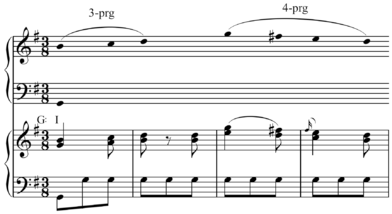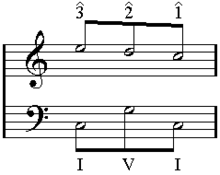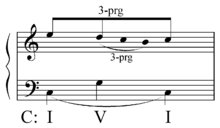Linear progression
In music, a linear progression (Auskomponierungszug or Zug, abbreviated: Zg.) is a passing note elaboration involving stepwise melodic motion in one direction between two harmonic tones.[2] "The compositional unfolding of a specific interval, one of the intervals of the chord of nature."[3] For example: ![]()
![]()
![]()
Linear progressions prolong harmonies through elaboration, or filling-in with dissonant notes, of a leap between two consonant notes from different voices in a chord.[8] In English they may be abbreviated "prg." such as 3-prg. for 'third progression' (rather than "Zg.").[8]

Note that in the Mozart example above the passing tones are dissonant and unable to be embellished; however, in the Urlinie example to the right the passing tone is supported harmonically, allowing for embellishment.[1] Also note the Schenkerian notation indicating relative hierarchical depth, surface or structural importance, where structural notes are indicated through stems and beams and surface notes are indicated through note heads only which are then slurred to stemmed and beamed notes. Thus in the bottom right example the third progression from D is a decoration of the deeper third progression from E.[1]
See also
Sources
- Pankhurst (2008), p.28-30.
- Pankhurst, Tom (2008). Schenker Guide: A Brief Handbook and Website for Schenkerian Analysis, p.243 and 27. ISBN 0-415-97398-8.
- Jonas, Oswald (1982). Introduction to the Theory of Heinrich Schenker, p.62. (1934: Das Wesen des musikalischen Kunstwerks: Eine Einführung in Die Lehre Heinrich Schenkers). Trans. John Rothgeb. ISBN 0-582-28227-6. The mention of the "chord of nature" in this context reflects Jonas' own opinion, which Schenker would not have shared, if only because the minor chord cannot be a "chord of nature". See Klang (music).
- Felix Salzer, introduction to the Dover edition of Schenker, Heinrich (1969). Five Graphic Music Analyses, p.14. ISBN 0-486-22294-2.
- Heinrich Schenker, Das Meisterwerk in der Musik II (1926), p. 24. English translation by J. Rothgeb, 1996, p. 9.
- Felix Salzer, Glossary to Schenker (1969), p.26.
- Snarrenberg, Robert (1997). Schenker's Interpretive Practice, p.19. ISBN 0-521-49726-4.
- Pankhurst (2008), p.28.


